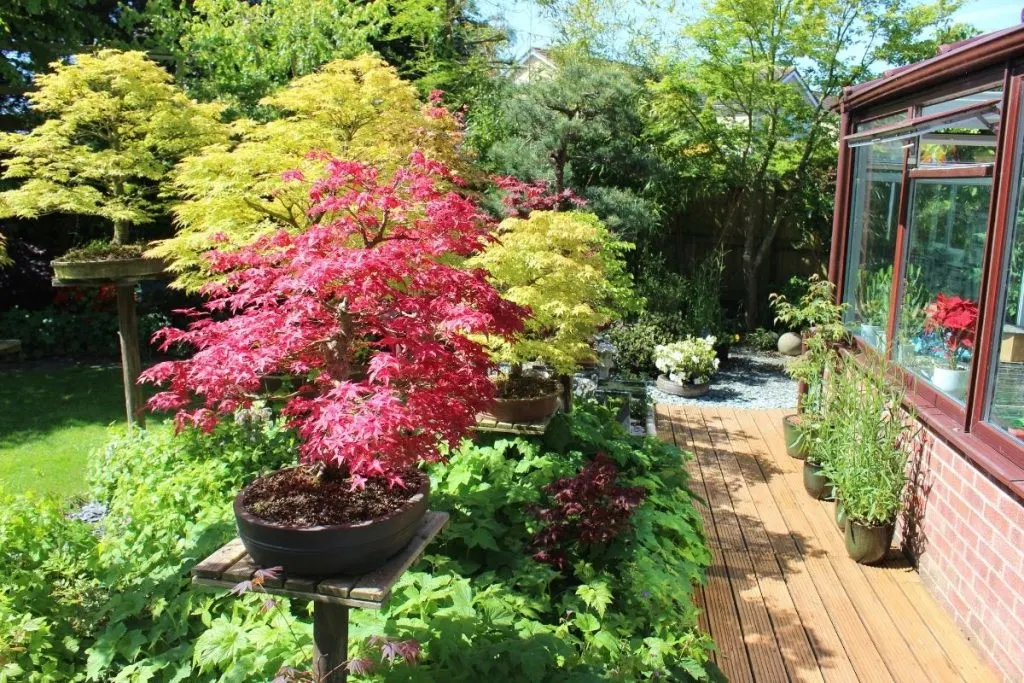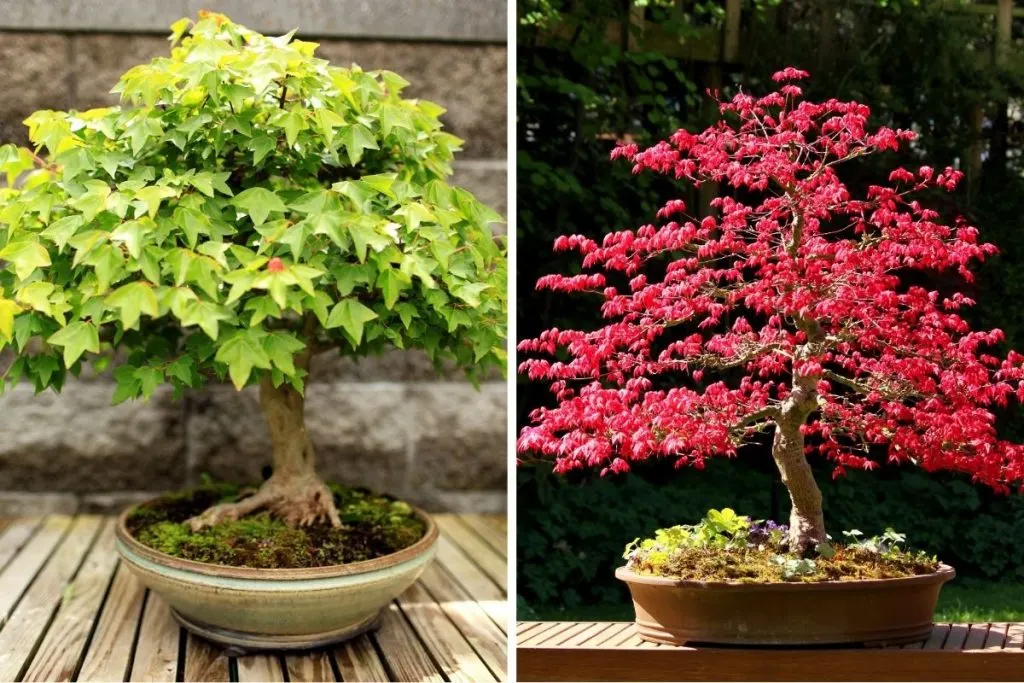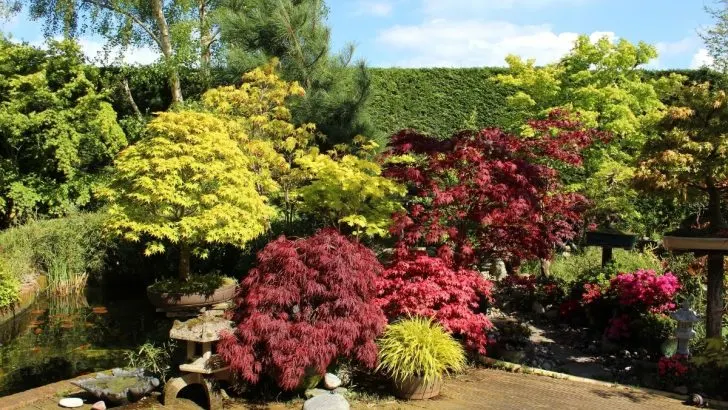Japanese maple bonsai trees are a gardener’s dream come true. Known scientifically as Acer palmatum, these trees are celebrated for their breathtaking transformation each fall.
Imagine the thrill of watching your bonsai’s deep purple leaves shift to a mesmerizing, luminous pinkish-red as October gives way to November. It’s not just a garden staple but a visual spectacle that commands attention and admiration.
If you’re a bonsai novice yearning for simplicity without sacrificing beauty, Japanese maples are an excellent starting point. Their adaptability to small pots and receptiveness to pruning and shaping make them perfect for a beginner.
A few snips here and a little care there, and soon you’ll have a canopy boasting the iconic palm-shaped leaves that these miniature marvels are known for.
Growing bonsai is more than just a hobby; it’s a journey that invites you to slow down and savor the process. In our fast-paced world, who wouldn’t treasure a meditative escape into the art of bonsai cultivation?
Whether you’re working with a petite terrace or a sprawling garden, tending to these tiny trees is a rewarding adventure that could very well become your next passion project.
Unveiling the Art of Bonsai Care

Caring for bonsai trees can be a bit like solving a lovely, intricate puzzle. At first glance, it might appear daunting, but with guidance grounded in centuries-old traditions from Japan and China, you’ll find bonsai care to be more accessible than expected.
While other plant enthusiasts may shy away fearing complexity, you can dive in with confidence, knowing that Japanese maples are the ideal species to hone your skills.
Understandably, growing bonsai involves more than just traditional gardening techniques. It demands patience and a touch of artistry.
This unique craft is not just about nurturing plants; it’s about creating living art that commands mindfulness and devotion. Perfect for anyone looking to merge horticulture with introspective creativity.
For those curious souls ready to embark on this journey, it’s encouraging to know that Japanese maples are not only forgiving but also a delight to work with.
Their nature adds a layer of tranquility to the otherwise bustling hobby of gardening. So, if you’re new to bonsai and seeking to dabble in this art form, consider starting with a charming Japanese maple.
Setting the Stage: Preparing Your Bonsai

As you begin your bonsai adventure, choosing the right environment is key. Japanese maples thrive in conditions that mimic the gentle shade of a woodland edge. This means they prefer soft, dappled sunlight rather than harsh, direct rays.
Imagine them as the introverts of the plant world—content and productive when they’re sheltered from the spotlight. Ideal planting conditions are found in USDA hardiness zones 5 to 8, where winters don’t dip below -20°F (-29°C).
When selecting a pot, opt for a shallow bonsai planter with ample drainage. These species despise having soggy feet (roots), so proper drainage is crucial.
Think of it as ensuring their shoes aren’t perpetually soaked—a move any plant would appreciate. For those interested, bonsai ceramic pots are readily available online, including platforms like Amazon.
Soil choice is equally vital in setting the stage. A specialized bonsai mix, rich in drainage-providing grit, is your best bet.
This ensures your tiny maple doesn’t sit in waterlogged conditions but enjoys a balanced, well-drained habitat. It’s like offering them a comfortable home where they can thrive and stretch their roots with ease.
Embrace the Messenger: Variations to Explore

When choosing your Japanese maple variety, consider those with smaller leaves and a more compact growth habit for the best bonsai results.
Acer palmatum ‘Deshojo’ is a popular choice, with its flamboyant orange-red foliage that lights up any space it inhabits. It’s like having a little piece of a fiery sunset right in your garden.
Another delightful option is Acer palmatum ‘Katsura’, celebrated for its striking yellow leaves with a unique crimson border.
This variety not only boasts beauty but suits hardiness zone 6 and above, making it a versatile candidate for various regions. Pair it with a colorful planter for an extra pop of visual delight.
For those who revel in the rich tones of plum-purple, Acer palmatum ‘Crimson Queen’ offers a majestic option. With a weeping form, it’s a stunning addition to any bonsai collection, particularly enchanting when its foliage transitions to bright red in the fall.
Available through vendors like Walmart, these live bonsai plants bring a touch of elegance and drama to your garden.
Ongoing Nurture: Caring for Your Bonsai

Once your bonsai is settled in its new home, ongoing care becomes an engaging ritual. Training your bonsai involves using small canes and wire to shape young, flexible stems.
This process, akin to carefully guiding a young artist, allows your tree to develop a beautiful, miniature canopy reminiscent of its full-sized counterpart.
Pruning and shaping are ongoing tasks throughout the growing season. Think of it as regular grooming, ensuring your bonsai remains tidy and retains its intended form.
This process requires precision and patience but ultimately leads to a stunning display that belies its small stature.
Watering your bonsai is a delicate balance. During spring and summer, when warmth abounds and containers dry out quickly, submerge the pot in water to allow for thorough hydration—much like giving your bonsai a refreshing soak in a cool pond.
Yet remember, overwatering is not their friend, so ensure the drainage hole remains unblocked.
Feeding is another crucial aspect. Throughout the active growing months, regular fertilization supports your bonsai’s health.
Consider it gourmet dining for your plant—a necessary indulgence to keep it thriving. In colder months, when the bonsai rests, you can ease off the fertilizer, allowing it to recharge naturally.

